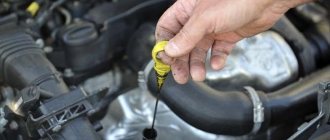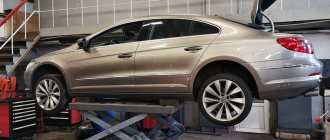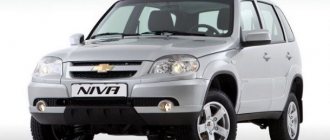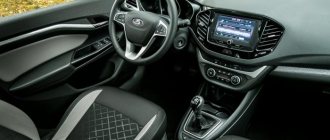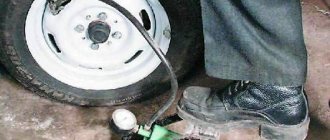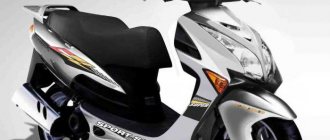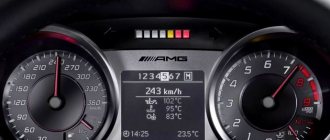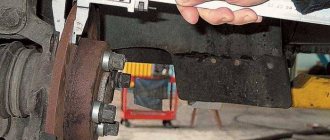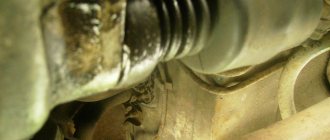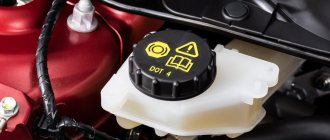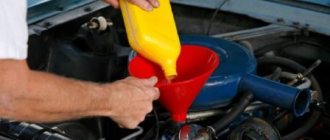A modern car is a complex vehicle that requires regular monitoring and maintenance. After all, sometimes when driving, even on a good road surface, it makes unusual sounds - crackling, knocking, grinding, etc. Literally all of them indicate a malfunction of certain units, components and parts. Therefore, it is very important to notice the malfunction and eliminate it in a timely manner, otherwise the damage to the car will be even greater.
Creaking in the front suspension is the most common phenomenon, since it is the chassis components that constantly experience increased loads and shaking. This causes wear on the moving joints, which is further exacerbated by sand, water and dirt. As a result, driving becomes unsafe, and it is imperative to look for the causes of the grinding noise - this will reduce the risk of an accident and extend the service life of this part of the car. You should look for a “weak spot” in the chassis depending on when the noise manifests itself, when driving straight, braking or turning.
NOTE. If the vehicle's chassis is configured correctly, there should be no squeaking or grinding noises. However, it often appears in cars not only with high mileage, but also in relatively new ones. To find the source of extraneous noise, you should moisten the friction pairs and hinges with special lubricant or water. The disappearance of the squeak will indicate which part has worn out. The same thing happens when a car drives into a deep puddle: water gets on the joints and usually the noise disappears; but as soon as the defective suspension elements dry out, it manifests itself again.
Grinding noise when driving a car, let's look at the reasons
20.08.2019
| (Votes: 5, Rating: 5) |
Issues discussed in the material:
- What can cause a squeak in the wheel when driving?
- Why do the wheels on Kia Rio and Lada Kalina squeak?
Sometimes, when operating a car, malfunctions occur that do not affect the overall performance, but irritate the driver and passengers with their manifestations. This characteristic problem can be called a squeaking wheel when the vehicle is moving. What causes the squeak, and how to eliminate it?
Mechanical damage
While driving over bumps and potholes, the wheel or wheels rub against the fender liners, which indicates a malfunction of the suspension and shock absorbers, as well as wear of the silent blocks. In a front-wheel drive car, a grinding noise when driving in the front end occurs when the front wheel hub bearing, as well as the CV joint, breaks down.
Replacing car silent blocks in Moscow
- Replacing silent blocks in Moscow: 870 car services with reviews
- Up-to-date information on prices and a convenient filter for searching
- Prices from 300 to 6000 rubles.
How to deal with this?
Now let's try to figure out the brake mechanisms on the rear wheels. To carry out troubleshooting, you need to hang the rear wheel. To do this, raise the rear of the car using a car jack, and for safety you need to install an additional stand. Only after this can you begin to remove the wheel and carry out diagnostics. While it has not yet been removed, it is advisable to check the play of the wheel bearing. To do this, grab the tire with your hands and try to shake it in the horizontal and vertical directions.
Now they try to remove it from the hub, usually this is not a problem, they will arise when it comes time to remove the brake drum. It is rarely removed, so it is possible for the aluminum brake drum to “stick” to the steel hub. Experts recommend that after removing it, slightly widen the hole on the drum to prevent this from happening again in the future.
The squeaking noise can come from the brake pads and drum. Some owners independently change the friction linings on the pads, riveting them with aluminum rivets. If there is significant wear, these rivets may rub against the drum, which will cause unpleasant sounds. With prolonged use of the machine, wear occurs on the inner surface of the brake drum, which is expressed by the appearance of an edge. The friction of the brake pads against these protruding parts of the drum can cause squeaking.
What to do if a pedestrian gets hit by wheels (regardless of the circumstances)
The first rule for all participants in an accident is to never leave the scene of the accident. If necessary, it is necessary to provide first aid to the victims, as well as record eyewitness accounts, if any. After this, all that remains is to wait for the traffic police to arrive and a possible trial.
Actions undesirable if a pedestrian throws himself under the wheels and you hit him:
- Transport the victim to a medical facility yourself. This will mean leaving the scene of an accident, which, according to Part 2 of Art. 12.27 of the Code of the Russian Federation on Administrative Offenses entails punishment in the form of administrative arrest or deprivation of a driver’s license for up to 1.5 years.
- Offer the victim or his relatives compensation for damage on the spot. Perhaps they will even agree, but where is the guarantee that after a few hours they will not change their mind and file an application against you?
If a pedestrian throws himself under the wheels and is hit by you, the following measures must be taken:
Inspect the roadway for signs of braking. An emergency sign should be placed at the point where they begin; this will serve as proof that the driver did everything possible to prevent an accident. Call an ambulance and the traffic police, and before their arrival, if possible, provide the necessary assistance to the victims. If there were witnesses nearby, try to involve them in recording testimony. Sometimes, after a pedestrian has thrown himself under the wheels, he assures that everything is in order and intends to leave the scene. This must be reported to the traffic police, and also enlist the support of eyewitnesses. In case of serious damage, you should find and record the location of glass fragments and other parts of the car. Using these elements, experts will be able to determine the exact location of the collision.
Pay attention to the presence of uneven roads, its slope, as well as the location of road signs. Any details related to the accident should be photographed with a camera or mobile phone camera. Carefully read the protocol drawn up by the traffic police officers, check the accuracy of the information provided and the measurements taken. You can put your signature only after you are completely convinced of the accuracy of the data.
What can cause a wheel to squeak while driving on a KIA Rio and Lada Kalina
1. Grinding noise in the wheels when driving a Kia Rio.
Kia Rio is one of the most common budget class foreign car models in Russia. This compact car quickly gained popularity among domestic car enthusiasts, becoming a worthy alternative to the products of the Volzhsky Automobile Plant.
However, the status of a budget car has a certain number of disadvantages, since the manufacturer is primarily interested in reducing the final cost, saving on quality. One of these problems is the appearance of noise and squeaking in the wheels when driving after the start of operation.
The reason for the rapid appearance of noise is due to the following points:
- The silent blocks and stabilizer bushings of this model are quite weak. Low air temperatures contribute to the rapid cracking of elements, which generates unpleasant noises when driving. In this case, only replacing consumables will help.
- Similar to the cases listed above, the brake pads are probably worn out, the wheel bearing has failed, and the calipers have defects. It is possible that the connection between the rotating part and the stationary part has been corroded. These malfunctions can be eliminated using the methods described above.
- A characteristic gurgling sound or sounds reminiscent of two metal pieces grinding against each other sometimes occurs when braking a Kia Rio. They appear due to imperfect operation of ABS made from cheap components. Such a system does not have noise absorption elements that are equipped with cars of higher classes.
An unpleasant squeak when braking is created by a mechanism that does not allow the pads to be pressed tightly against the brake disc. The sound will continue until the driver releases the brake pedal. The more worn out the friction linings on the pads are, the louder the sound will be, which will disappear only after replacing the consumables.
The Kia Rio is not intended for off-road driving, therefore normal operation will be ensured only if the load is evenly distributed on each wheel. Driving over uneven surfaces will create increased pressure on a frame that is too weak for off-road use.
This causes single creaks in the suspension during movement and rapid wear of its elements. In this case, compressing the springs beyond normal sometimes leads to the formation of cracks on them.
A budget car like the Kia Rio lacks most of its noise-canceling elements. Therefore, extraneous sounds in more expensive models are, as a rule, absorbed and do not interfere with driving, despite the fact that they are partially audible in the cabin.
2. Creaks in the rear wheel when driving the Lada Kalina.
The quality of domestic cars is growing every year, since the joint work of Russian and foreign engineers allows us to think through every little detail more carefully when creating the next concept. However, an attempt to reduce the cost of manufactured products for the Russian consumer often leads to insufficient modification of some automotive components. The extraneous sounds that arise during the operation of the car as a result of these shortcomings cause a certain discomfort among car owners.
Suspension
Creaking in the chassis can accompany cornering, overcoming bumps, turning the steering wheel - each maneuver separately or all together. Usually, one of the ball joints plays the role of a “loudspeaker” here - a ball joint, a steering tip, a stabilizer link, a suspension link. Over time, these components may be left without the lubricant that was put into them during assembly or during scheduled maintenance - it either dries out over the years, or is washed out with water after the boot breaks. Dust and small particles of sand, having got into a joint with a damaged cover with water, also often play “their part” in the accompaniment. The metal parts of the hinge that remain “dry” can begin to corrode directly along the working surfaces, which leads to an even greater acoustic effect.
Creaks in the chassis are usually caused by one of the ball joints. Over time, they may be left without lubrication - it either dries out or is washed out with water after the boot breaks. The metal parts of the hinge that remain “dry” can begin to corrode along the working surfaces, which leads to an even greater acoustic effect
Sometimes the creaking in the suspension disappears for a while, usually in wet weather when the hinge is “lubricated” by rainwater. Accurately diagnosing a noisy unit is often difficult, even on a pit or lift, since this type of high-frequency noise is difficult to localize. They identify the “creaking” one by ear and touch - a faulty hinge usually emits a vibration that can be felt by the hand in synchronization with the creaking. A “sick” hinge can also be revealed by its appearance: external corrosion, a torn protective boot. In principle, noisy operation is not yet a sign of complete wear, and such a unit can still serve if the craftsmen manage to replenish the lubricant supply in it.
Brakes squeak: 5 main reasons
Natural vibrations
When the pads press against the brake rotor to stop it, they vibrate. Due to the acoustics created by the wheel arches, this sound is amplified and becomes so loud that it can be heard.
It is that very light squeak that a fully functional brake system can emit constantly.
To prevent this from happening, some pad manufacturers supplement them with special linings that dampen resonance. Another method is one or two slots with a width of 2 to 4 mm on the working surface of the part: this way the area that comes into contact with the disk is reduced and the resonance is reduced. This reason for a squeak is not a reason to worry and make an appointment with a car mechanic.
New pads
At the factory, they are coated with a special protective layer containing impurities, which can cause whistling and squeaking until it is completely erased. To reduce its wear time, you need several emergency braking, that is, you need to reach a speed of no less than 100 km/h and stop sharply. At the same time, be sure to follow safety precautions. If it becomes clear that the cause of the squeak is precisely friction on the discs of the new pads, the intervention of service center specialists is not required.
Emotions from squeaking brakes
Incompatibility of pad and disc materials
This situation can arise for two reasons:
- Despite the fact that the same materials are used to produce pads, each manufacturer selects their ratio independently. The situation is similar with disks. And then the material of the friction layer of the former during braking may conflict with the cast iron of the latter.
- A condition under which even long-installed pads can begin to creak: their physical properties have changed after heating and sudden cooling. This happens if a car that has been on the road for a long time gets its wheel into a deep puddle, or if the car has been standing in line for a long time to be washed in the heat. The result is an unpleasant sound that can only be eradicated by replacing the pads. This malfunction does not require urgent intervention, but the cause of the squeak can only be eliminated in a car service center.
Disk overheating
Constant physical activity combined with high temperature in some cases affects the geometry of the disc even without sudden cooling. And when it loses its original adjusted shape, it inevitably comes into contact with other elements of the system during braking. To get rid of the whistling or even grinding noise in such a situation, you need to replace the brake disc. And here you cannot do without an urgent visit to the service center.
It's time to lubricate the mechanism
In addition to the disc mechanism washer itself, which is attached to two or even all four wheels, the brake system has quite a few mechanical components that require lubrication.
The design of the brake system indicating the key mechanisms
Therefore, if squeaking and whistling have become constant companions of car trips - that is, they are heard not only during braking - there is a high probability that the reason is insufficiently well-lubricated mechanisms. In general, such a problem does not affect the operation of the components, but can shorten their service life, so urgent intervention remains at the discretion of the car owner. You can treat the parts with special technical oil yourself if there is a hole or another opportunity to get close to the system.
Causes of squeaks
In the last century, antifriction material was attached to the base of the pad with rivets, the heads of which were recessed into the lining to a certain depth. When critical wear occurred, the metal of the rivet rubbed against the disc, producing a creaking sound. It served as a sure sign that the linings had thinned to a minimum and needed to be replaced.
We recommend: Replacing the low beam bulb on a Lada Priora: 3 best brands and step-by-step replacement technology
Nowadays, the fastening of anti-friction elements is done in a more technologically advanced way, so friction of the rivets on the disks and drums is eliminated. There are several common reasons why modern brake pads squeak when you press the pedal:
- Natural wear of the working surface.
- Unevenly worn brake drum or disc, presence of deep scratches.
- Incompatibility of the material or coating with the system of a particular vehicle.
- There are no special grooves or curves to prevent the occurrence of grinding noise. Other design features.
- Wear of certain parts of the vehicle's chassis - calipers, guides, pistons and wheel bearings.
A secondary cause of squeaks on the front of the car is the ingress of water, dust, dirt and process fluids onto the working surface of the disc. The latter include various oils and brake fluid leaking from under the soggy cylinder cuffs.
Drum systems are better protected from external influences, but transmission oil from the rear axle gearbox often penetrates there when the oil seal is worn out. The malfunction can be easily traced by drips on the inner plane of the rear hub.
Wear of brake parts
Front disc brakes operate according to the following principle:
- the driver presses the pedal and the piston of the master cylinder begins to displace fluid into the system circuits;
- under the influence of hydraulic pressure, the piston moves and presses the pad to the plane of the disc;
- at the same time, the second pad is pulled along the guides, grasping the disk on the other side and slowing down its rotation.
If there are backlashes or jams in the mechanism, and the anti-friction layer has become thinner to the limit, the working planes will become less able to fit together. As a result, vibration and squeaking noise will occur when braking.
Advice. Creaking and shearing that occurs from wear of the chassis is unlikely to be eliminated by replacing the pads. The problem is more global - it is necessary to change all the parts that have worked together.
In a rear drum system, a cylinder pushes 2 shoes apart using two pistons. The wear of the linings and the uniformity of wear on the inner surface of the drum play a role here. There are often cases when, after replacing the rear pads, an unpleasant whistle appears, caused by uneven friction on the metal surface. A similar effect is also observed on discs with deep circular grooves and transverse scratches.
We recommend: How to replace a VAZ-2114 pump with your own hands
Working pad material
When selecting the composition of the working part of brake pads, each manufacturer tries to find a middle ground between wear resistance and softness of the antifriction material. The harder the surface of the lining, the longer it will last, but the higher the likelihood of grinding. Conversely, a soft composition will never creak, but will wear off quite quickly.
This results in incompatibility of the pads with the metal of the wheels of a particular car brand. Often, a car enthusiast who has replaced worn parts with products from another brand with a harder surface discovers that the brake pads are squealing. This fact does not at all indicate low quality of spare parts, but speaks of banal incompatibility.
Reference. Manufacturers often apply a special wear-resistant coating to the working surfaces, which can cause squeaking during the first kilometers of driving. Do not rush to make drastic decisions and remove new parts from the car until you have ground the surfaces through a short run-in.
Pad design features
To minimize vibrations and rattles during braking, manufacturers are trying in every possible way to improve the design of anti-friction linings. An example of such modernization is:
- division of the rubbing plane into 2–3 sectors by deep grooves;
- making roundness and indentations along the edges of the part adjacent to the disk;
- installation of various anti-squeak plates.
The purpose of dividing the surface into sectors is to reduce the plane of simultaneous contact and in this way increase the frequency of the scratching sound wave to a threshold inaudible to humans. At the same time, the weight and cost of spare parts are reduced. The approximate width of each groove is 2 mm, and the depth is at least 4 mm. It is envisaged that after the grooves are developed, the pad will finally rub against the disc and will not whistle.
The recesses and rounding of the ends of the linings are made so that the working surface rubs against the metal gradually. During operation, the contact area increases, but the brake pads do not creak. For the same purpose, additional anti-creaking plates are installed.
If a car came with upgraded pads from the factory, and then the owner decided to save money and install simpler and cheaper products, there is a chance of getting brake grinding when you press the pedal sharply. This will serve as an additional argument in favor of purchasing original and high-quality parts.
Reference. Some products are equipped with wear indicators made in the form of soft metal plates. When the anti-friction part wears out, the element touches the edge of the disc and notifies of critical wear with an unpleasant sound.
The grinding noise constantly intensifies and is quite sharp.
One of the most common situations in which you will need to use the help of specialists at a service station is an increase in grinding or a sharp, strong sound of metal rubbing against metal. Most likely, the block is completely worn out; you continue to brake with the sole of the block, which is made of hard metal. If this problem is not addressed promptly, the brake disc may fail and require replacement. In this case, repairs will be three times more expensive, so it is better to immediately identify all possible malfunctions and problems that caused the grinding noise when braking. In particular, to diagnose this problem, it is enough to carry out the following processes:
- determine from which side the grinding sound is heard, this will help you halve the amount of work required for diagnosis;
- remove the wheel that you suspect is making unpleasant sounds when braking;
- examine the exposed brake disc for grooves, chips and other problems with the working surface;
- look at the remaining layer of the brake pads, determine the degree of wear and the need for replacement;
- also examine the second wheel on this side, and best of all, examine the braking system on all wheels;
- Identify possible problems that could lead to squeaking and consult with specialists.
This will often help you determine the cause of the squealing noise when braking for free, but disassembling the brake system and performing repair work yourself is not always wise. You can use the services of specialists and guarantee the normal operation of the brake system. However, it is quite possible that all braking systems visually appear to be in good working order, but the grinding noise is still present. Then see if the car's behavior has changed during braking. If there are changes, you will have to pay more attention to this problem. If there are no changes, you can continue to operate the car until the grinding noise intensifies and gives specific clues.
Other causes of squeaking when driving a car
It happens that drivers feel extraneous squeaks or noises while driving a vehicle, but none of the above reasons are suitable for diagnosis, and the real reason for the problem lies in something else. So, among the most obvious reasons are the following:
- The main problem often lies in overinflated tires, because the driver or tire mechanic may have forgotten to look at the recommended pressure parameters in the cylinders before inflating the air. Thus, if the tire is given a pressure of 2.6 atmospheres instead of the recommended 2.4, this may lead to squeaking while driving when the surface rubs against the asphalt and especially when cornering.
- If your car has winter tires or studs, then when driving fast on a hard surface they will definitely knock on it, causing a lot of noise, and the higher the speed, the stronger it will be felt in the cabin. The same applies to Velcro, because it will begin to make squelching sounds on the asphalt or the front wheel of the car may squeak.
- If the car is driven off-road, the owner may feel some kind of knocking on every bump. This means that the suspension ball elements or arms on it have become loose or worn out and require prompt diagnosis, and then repair or replacement.
Principle of operation
All hydraulic brake systems operate on the same principle:
When you press the brake, the pressure in the brake hydraulic system increases, the brake calipers, through the pistons, press on the brake pads, which are pressed against the disc or drum and, due to the frictional force, slow down or stop it. The pressure (of the calipers) in the brake system directly depends on the force of pressing, that is, on the distance that the brake pedal has traveled. In other words, by pressing the force, you can regulate the pressure and change the braking torque, that is, slow down, or vice versa, with full pressure, you can brake urgently.
The source of unpleasant, extraneous sounds in the brakes can only be moving parts:
- pads (front and rear);
- caliper (piston);
- brake discs or drums (deformation);
- brake pedal (lubrication);
- wheel hub (play);
How to deal with a grinding noise on the front wheel of a Nissan Premiere
Thus, if a motorist experiences discomfort from piercing noise while driving, he needs to take the following steps:
- Stop the car, get out of it and gently rock it on the right and left sides. If he hears an extraneous sound under this influence, then there is almost certainly a problem with the suspension. Or rather, with the silent block of one of the shock absorbers. In such cases, as a rule, further operation of the car for short distances and on a flat road does not threaten anything, but if the driver completely neglects the problem, then consumable parts can fall apart and harm the entire system, which will lead to long-term, expensive repairs.
- If the Nissan does not make any sounds when rocking, then the problem lies in the brake system or hub. The best solution here would be to put the front-wheel drive car in neutral, lift it on a jack, and then carefully turn the wheel clockwise and back. If you hear a creaking noise, then there is 90% a problem with the bearing on the hub, and in this case you need to immediately go to the nearest tire shop or car service center, where the part will be replaced.
- If none of the diagnostic options led to results, and the sound was not detected, then the problem may only be hidden in the brakes, and the driver needs to change the pads, and it is best to purchase them in the original.
Friction of rubber on metal
Reasons for appearance
Such sounds are caused by several factors:
- malfunction in the brake system;
- damage to CV joints;
- wheel bearing failure;
- differential failure;
- gearbox failure.
When braking
The usual scenario is how this happens. After sharp acceleration and subsequent pressing of the brake pedal on a flat road, something in the front end begins to creak and knock. One of the possible causes of the malfunction is a broken pad pressure spring. It is also possible that the anti-squeak plate has fallen out - because of this, the block begins to move up and down and click. It is recommended to check for play with a mounting tool.
It happens that brake calipers become dirty or weakened. When one of the bolts falls out, a grinding noise in the front wheel when braking is inevitable, because the mechanism begins to hit the wheel. This leads to uneven wear and grinding of the disc on the left or right side. But damage to the pistons usually reveals itself by squeaking or shuffling. Clicks also occur due to deformation of the guide pins (fingers). In this case, noise appears not only during braking, but also when driving on uneven roads.
Shoes begin to grind and clatter after significant wear or contamination. This is also possible with new parts if the last ones are defective. Pads are consumable material, so they need to be replaced periodically. It is recommended to buy parts designed specifically for this car model.
The ball joint also causes clicking noises. If it is heavily worn, then when the car brakes, a serious load is placed on it. The result is grinding and knocking noises.
- the lower ball joint is faulty or lacks lubrication;
- silent blocks or stabilizer bushings are destroyed;
- thermal deformation of disks;
- ABS is faulty - it disappears immediately if there is a single click.
When driving
Sounds in the area of the front wheel, reminiscent of a metallic clang. The nature of the malfunction is as follows. After sharp acceleration in D mode and subsequent incomplete braking (the car is in motion), clicks are heard. They are also noticeable in R mode. As a rule, they occur when moving forward or backward for the first time. No noise is observed when overdrive or reverse speed is turned on again. The noise in this case indicates damage to the internal grenade or transmission differential. It is also possible that the gearbox is failing.
Most common problems
Braking
Since squeaking brakes when braking is one of the main complaints associated with this problem, a whole range of measures is needed to diagnose and eliminate the defect. It is necessary to identify the side that is squeaking, remove the wheel and evaluate the condition of the brake pads.
We recommend: 12 best preheaters
Measure the runout of the brake disc, the presence of a service groove and, if necessary, grind (on a special machine - stand) or replace the brake discs (if there is a malfunction, a pair of brake discs is always replaced).
Check the presence of metal anti-squeak plates and their condition, make sure that there are no foreign objects in the brake and wheel mechanism, and also evaluate the condition of the suspension and brake caliper parts.
If after checking there is still a squeaking sound when driving, then most likely there is a mismatch in materials, and you should simply replace the brake pads.
Rear brakes
There are many cars with rear drum brakes, and although the design of the brakes is different, the principle of checking and repairing is approximately the same. The rear brakes are used as a parking brake, and sometimes the rear brakes squeak due to the need to simply adjust the handbrake.
When driving
This usually happens when the wheel bearing wears out or the brake disc is bent, when axial vibrations occur. The brake disc reaches the pad and causes vibrations, heard as creaking, squeaking, and so on. Usually eliminating the backlash and replacing parts (discs and pads) eliminates the problem.
Brake pedal
Braking system defects can also include squeaking brake pedal. Such a squeak usually indicates increased friction on the pedal axle. This can have a critical impact on vehicles equipped with ABS, as increased pedal resistance may adversely affect performance. It can be easily eliminated by simply lubricating the bushings and axle with a suitable lubricant.
If, after all the work and activities, the squeaking noise does not go away when you press the brake pedal, you need to turn to professionals, since the braking system is a complex mechanism responsible for safety and even such a small thing as a squeaking sound should not be ignored.
Elimination: tips and tricks
Eliminating the causes of noise depends on the cause. If the noise is caused by damage to the tie rod boots, first remove the dirt accumulated in the mechanisms - VD-40 is used for this purpose. On damaged CV joints, new boots must be installed.
If the wheel alignment angle is abnormal, you can straighten the locker and drive to the nearest service center. And you can find and remove creaking caused by friction of plastic interior elements yourself.
Any power steering malfunction, including damage to the pump, must be repaired by a service center. Eliminating the main causes of squeaking on your own is extremely difficult and often pointless. It is much easier and faster to get help from specialists who are well versed in the design of a particular machine.
Poor quality pads, discs or uneven wear of elements
Brake pads and discs are consumables for a car, so car owners often purchase and replace these components on their own. Purchasing spare parts does not always happen from official suppliers; original parts are often unreasonably expensive. Therefore, we expose ourselves to certain risks by purchasing analog parts or spare parts of unknown origin. In this case, a huge set of problems is possible, which will become the main cause of problems and squeaks in the braking system:
- incorrect composition and insufficient softness of the metal in the working part of the brake pads;
- poor quality of metal in brake discs, lack of required strength and rapid wear;
- uneven wear of discs and pads, which causes ineffective braking and problems with automation;
- consumables fail too quickly, unexpected braking problems;
- poor efficiency and strong heating of discs and pads during friction, problems with the entire braking system;
- other classic problems when installing non-original equipment for your car.
These are the types of problems that can be caused by installing non-original pads and discs. This does not mean that you should necessarily spend money only on original parts, but you should not buy spare parts from an unknown manufacturer. It is better to increase maintenance costs and get high quality work of all machine components than to have problems with transport and with the main safety devices. By the way, if braking is ineffective and there are problems with the elements of this system, ABS and other safety devices also do not work. This makes the car defenseless against some types of obstacles, as well as when attempting emergency braking.
